Traditional German Spaetzle Recipe
This post may contain affiliate links. See my disclosure policy.
One of Germany’s most popular and beloved foods, here is a fool-proof and authentic German Spaetzle recipe, just the way my Mutti and Oma made it! Perfect texture and perfect flavor, these are just like you know and love them from the Swabia region of Southern Germany where they originated!
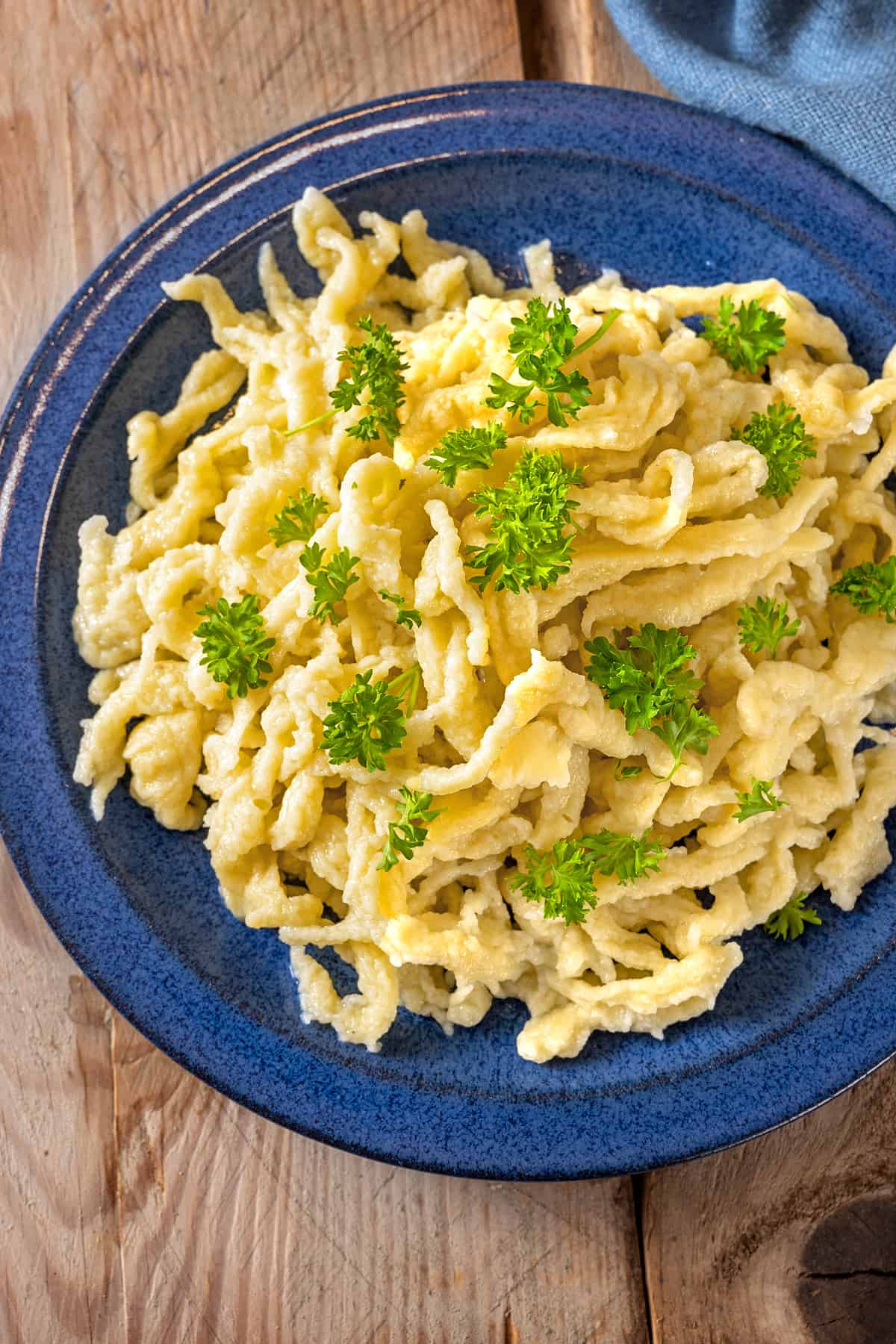
What is Spaetzle?
One of the most beloved foods in Germany that tourists go home talking about is Spaetzle, the famous German egg noodles from the Baden-Württemberg region of southwest Germany. This area is also known as Schwabenland, or Swabia. I grew up in Stuttgart, the capital of Baden-Württemberg, watching my Mom and Oma make Spätzle – I learned from the best!
Swabia is home to some of Germany’s best food (many, including myself, will argue it’s home to the best food in all of Germany). And that’s saying a lot because every region of Germany has amazing food. Swabia is known for its soups, sauces, meats, wursts, and salads, to name a few. It’s also home to some unique varieties of pasta including Spätzle, Schupfnudeln and Maultaschen.
Today we’re featuring Spätzle, a Swabian specialty that is also enjoyed in Austria and Switzerland. Spaetzle is a special type of egg noodle that is enjoyed with sauces and gravies as well as incorporated into a variety of different dishes. One example is Käsespätzle (a cheese spatzle casserole with crispy fried onions). Where did the name “Spätzle” originate? It comes from the German word Spatzen, meaning “little sparrows”, because that’s what they were thought to resemble when they were traditionally made by hand.
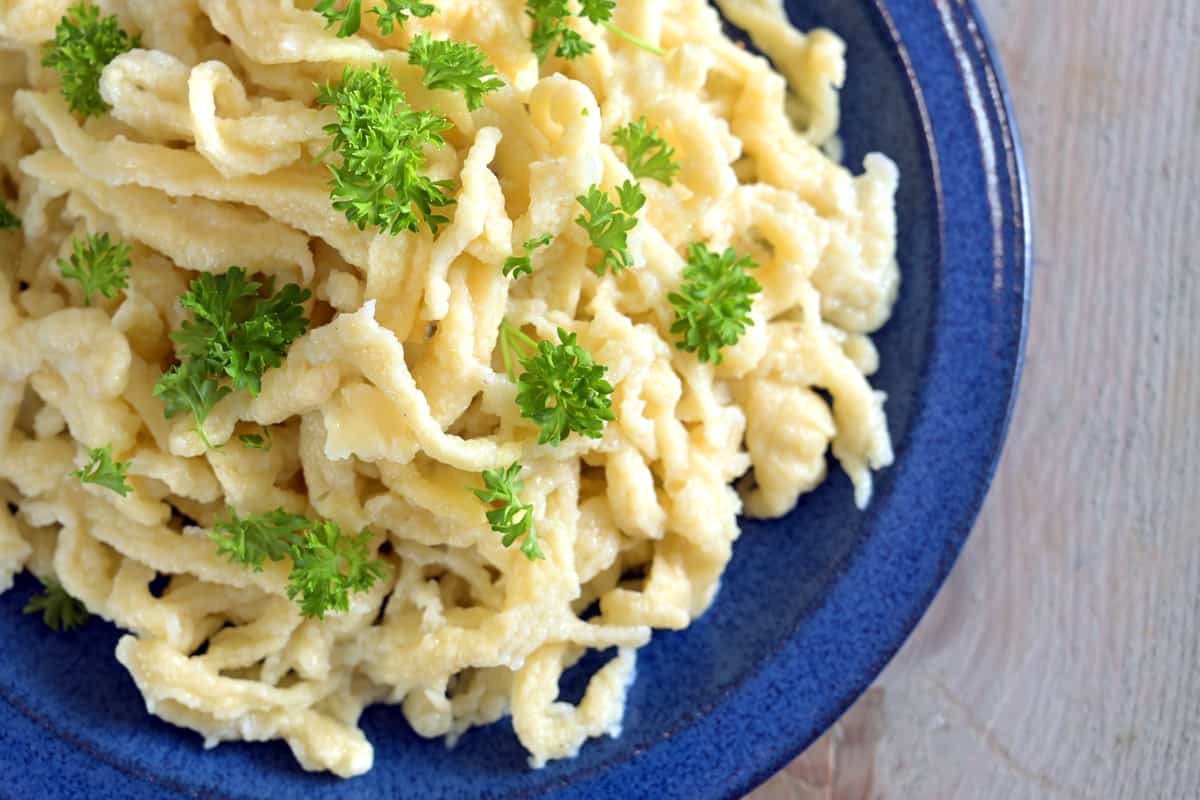
Spaetzle Ingredients
Spaetzle is a type of pasta and as such is made with a very few, simple ingredients that you’ll already have in your pantry. Here’s what you need:
- All-purpose flour: this creates a tender Spaetzle that still has a nice chewy texture.
- Eggs: these add richness and contribute to texture.
- Milk or water: You can use either but I prefer milk as it adds richness.
- Salt: enhances the flavor.
- Nutmeg: this is optional and is not traditional, though many German cooks today like to add it for flavor.
Spaetzle Recipe
Let’s get started!
This spaetzle recipe uses a stand mixer to knead/mix the dough. This is actually the first time I’ve made it that way. I’ve always done it by hand (you “knead” it by vigorously whipping it in a bowl with a spoon – over and over and over for around 20 minutes. It’s a lot of work!) I decided to to try it with a stand mixer instead and it turned every bit as good – and it sure saves a lot of muscle strain!
Add the flour and salt in the bowl of a stand mixer. Stir to combine. Crack four eggs into a bowl and whisk to combine. Make a well in the center of the flour and add the eggs. Add the milk or water and with the paddle attachment (I initially tried the dough hook and it didn’t work well), knead/mix the dough on the “2” setting for about 10 minutes to get a cohesive batter. Add more flour if the mixture is too runny, or more milk if it is too stiff.
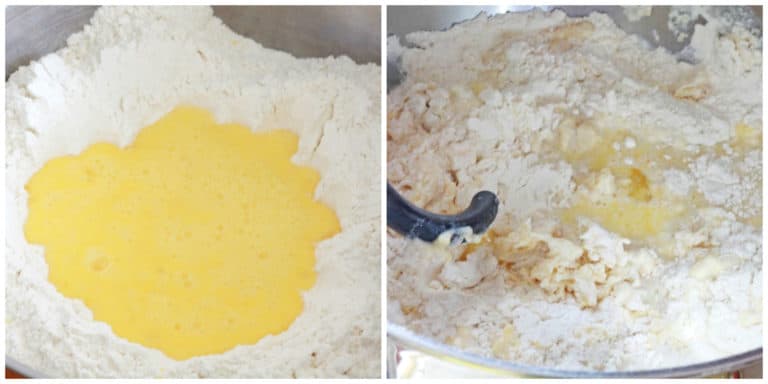
Pro Tip: How to Know When the Spätzle Batter is Ready
The batter is done when “bubbles” begin to form. After about 10 minutes of beating, use a wooden spoon and scoop and pull to stretch the batter; if bubbly holes appear, the dough is done. If not, continue “kneading” with the mixer for another minute or two, repeating the “test” process. See the bubble hole below?
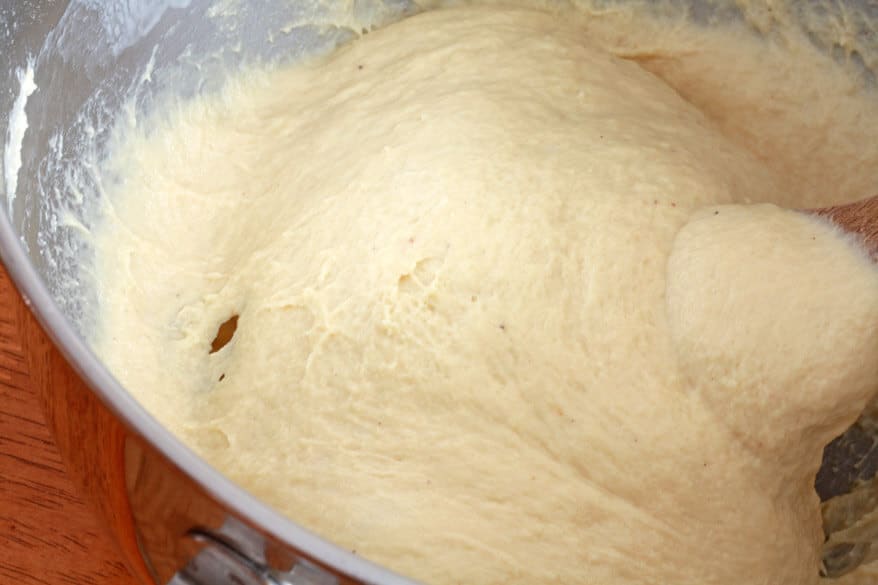
When those bubbly holes start appearing you know your batter is done.
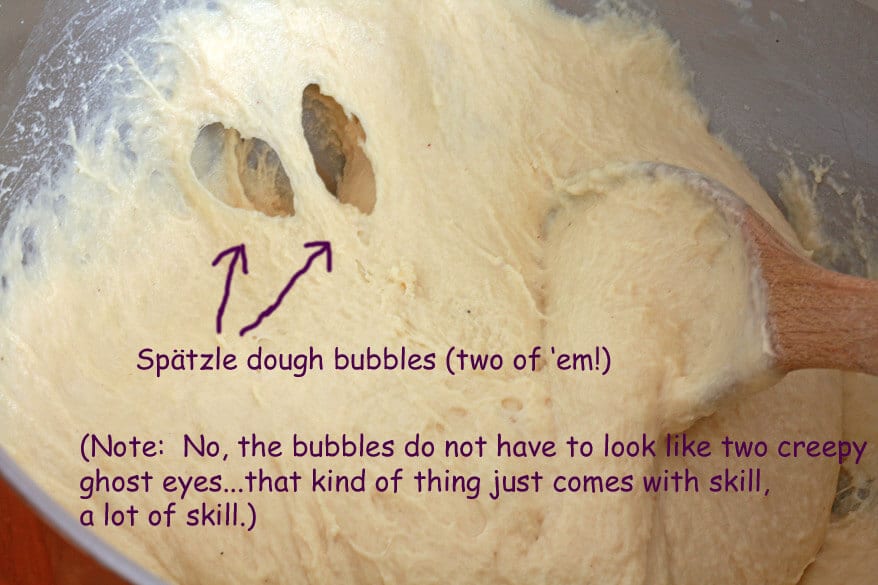
What Is the Best Spätzle Maker?
Now that the batter is read it’s time to make the Spätzle. And when it comes to the Spaetzle maker, there are a few options to choose from. Traditionally, Spätzle was made by hand using a Spätzlebrett, or Spaetzle board. You would rub a slab of dough out onto a wetted board and use a pastry cutter or long sharp knife to quickly cut off strands of the dough into simmering water. Swabian women of previous generations were highly skilled at this and could do it so fast it would make you dizzy to watch. Nowadays most Germans use a Spätzle maker (and even more just buy it ready made at the store. It’s the “convenience generation”).
Besides the traditional Spätzle board there are a few different kinds of Spätzle makers out there that you can find online:
- Spätzle Press (below left): That is my Spaetzle maker that I brought with me from Germany when I moved to the U.S. and it’s awesome. This kind is pricey but it will last a lifetime. It’s called the Original Kull Spätzle Maker and is made in Germany. It’s built like a tank and will become a family heirloom you can pass down for generations. Another brand that is much cheaper and is also made in Germany is this Westmark Spätzle Maker. These Spätzle presses can also be used as potato ricers.
- Spätzle Scraper (below right): Another option is the Küchenprofi Spätzle Lid & Scraper. I’ve used this one as well with good results and it’s much cheaper. It produces a shorter, stubbier spatzle noodle. Alternatively you can also use a metal steamer because it’s similarly constructed with large holes. You place some of the dough in the steamer over the simmering water and scrape the dough through the holes.
- Spätzle Plane: A third option is the Küchenprofi Spätzle Plane with Pusher, which is my least favorite as it can be a little clumsy, messy, and more difficult to work with but I know people who use it.
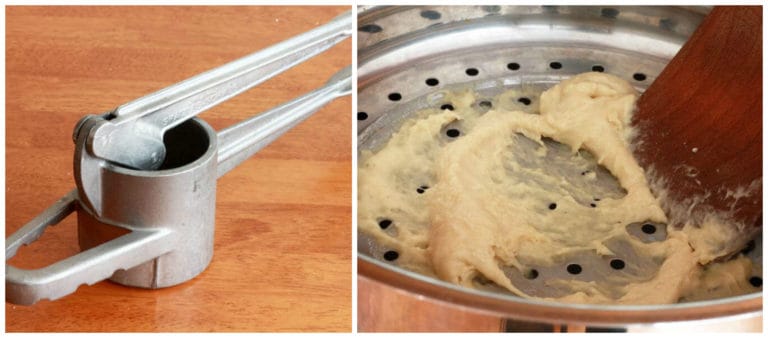
My personal favorite is the Spätzle press and that’s what I’m using in the pictures below. Place the Spaetzle maker over a pot of lightly salted simmering water and scoop some dough into it.
Press the Spätzle maker down to squeeze the Spätzle noodles out into the simmering water. Simmer the Spätzle for about 2-3 minutes or until they float to the top.

Using a slotted spoon, transfer the Spätzle to a colander and then immediately put them in a bowl of very cold water. This helps them firm up to the desired consistency.
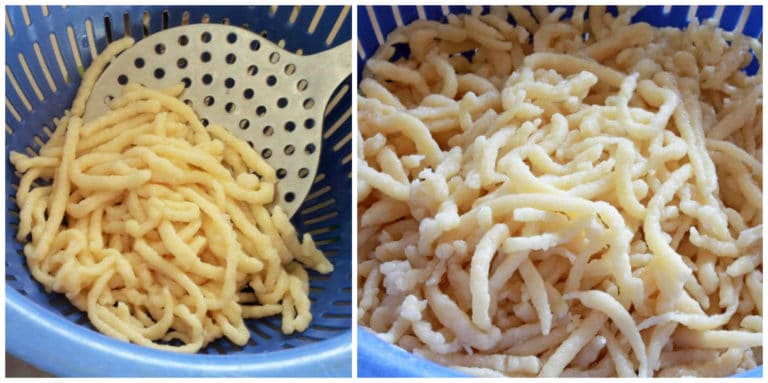
Drain the Spätzle again and toss with a little oil or melted butter to keep them from sticking.
Spätzle will keep in the fridge for at least a couple of days and then heated to serve. Melt some butter in a pan and toss the Spaetzle in it to warm through.
Storage & Freezing
Spaetzle can be made in advance, cooled, and stored in a covered container in the fridge where it will keep for 3-4 days. To reheat it you can microwave it in a microwave-safe container or, my favorite way, is to melt some butter in a large skillet, add the Spätzle and heat through. Spaetzle also freezes well for up 3 months: put it in a freezer-safe container and let it thaw overnight in the fridge. It can be reheated in the microwave in a covered container so that it doesn’t dry out, or you can melt some butter in a pan and toss the Spaetzle in it until warmed through.
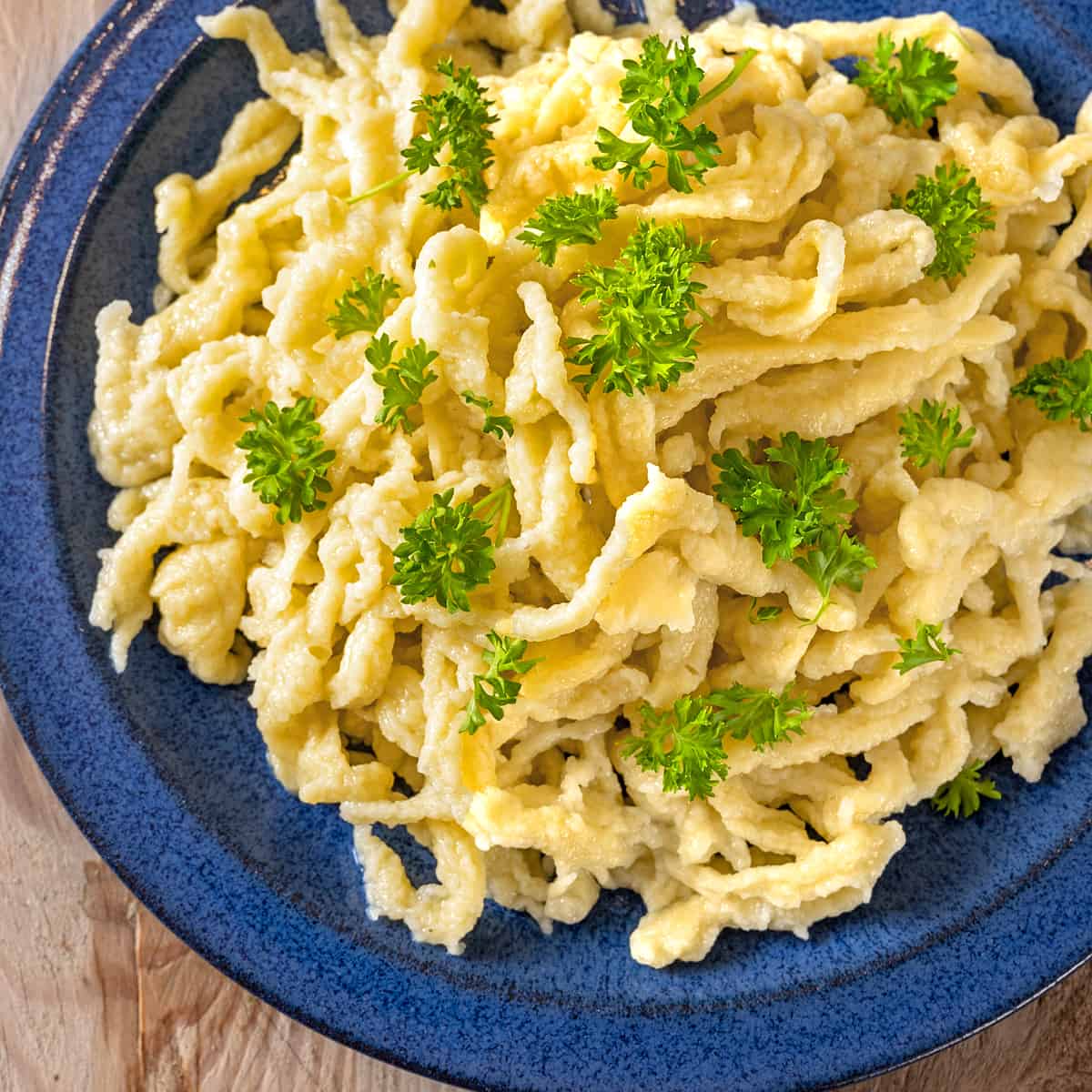
What to Serve with Spaetzle
Spaetzle is very versatile and can be served a variety of ways. Here are a ways to serve spaetzle:
- Buttered Spätzle: This is one of the simplest and most traditional ways to serve spaetzle. After boiling and draining the cooked spaetzle, toss them with melted butter and sprinkle with chopped parsley.
- German Cheese Spaetzle (Käsespätzle): Another Swabian classic and personal favorite, try my recipe for Käsespätzle (pictured below).
- With Sauces and Gravies: Spaetzle can be served with any sauce or gravy, like my favorite German Rahm Sauce, Onion Gravy, or Mushroom Gravy. Serve it with my classic German Goulash, Geschnetzeltes or Königsberger Klopse.
- With Meat Dishes: Spaetzle is the perfect choice to serve with any saucy meat dish like Jagerschnitzel, Rouladen, Sauerbraten, Pot Roast and Tri Tip Roast. It can also accompany your Schweinshaxe and Frikadellen.
- Pasta Salads: For a variation on traditional pasta salad, toss the spaetzle with fresh vegetables, herbs, a vinaigrette, and some diced cheese and ham.
- In Soups: In some regions, spaetzle is added to soups, much like dumplings. Drop small portions of spaetzle dough directly into simmering soup and let them cook until they float to the surface as in this Gaisburger Marsch and German Pea Soup.
Guten Appetit!
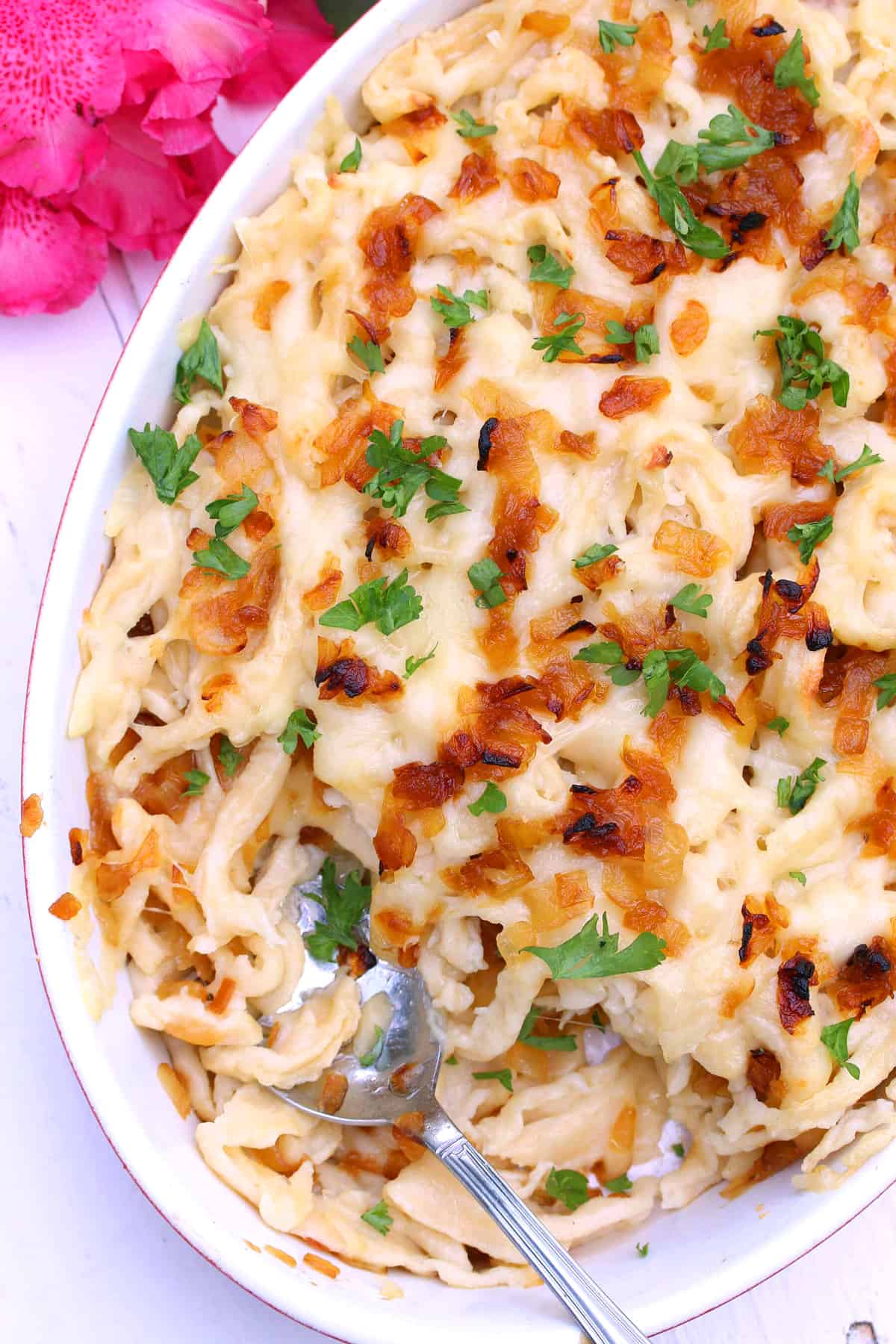
For more favorite traditional German dishes be sure to try my:
- Kaesespaetzle
- Rouladen
- Sauerbraten
- German Goulash
- Maultaschen
- Schnitzel
- Bread Dumplings
- German Potato Dumplings
- Zwiebelkuchen
- German Bread (Vollkornbrot)
- Bratwurst
- Currywurst
- German Potato Salad
- Rotkohl
Save This Recipe
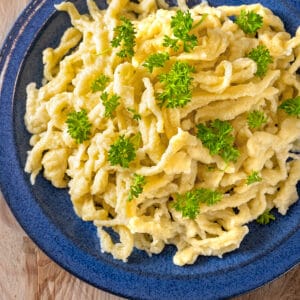
Traditional German Spaetzle Recipe
Equipment
Ingredients
- 2 cups all-purpose flour (you can also use whole wheat flour)
- 1 1/2 teaspoons salt
- 1/8 teaspoon freshly ground nutmeg , optional (not traditional but adds a nice flavor)
- 4 large eggs
- 1/2 cup milk or water + more as needed (milk produces a richer Spaetzle) (**add more flour if the dough is too runny, add more milk or water if it's too stiff)
- butter for serving
Instructions
- The Spätzle batter can be mixed by hand or by using a stand mixer which is much easier. Add the flour, salt and nutmeg (if using) to the bowl of a stand mixer. Stir to combine. Crack the eggs into a small bowl and whisk them. Make a well in the center of the flour mixture and pour the eggs in it. Add the milk (start with using slightly less and add more as needed). Attach a paddle attachment to the stand mixer and "knead" the dough for about 10 minutes or until bubbles appear (see pictured instructions for details). After 10 minutes or so of beating, use a wooden spoon to scoop and pull the dough. If bubbles/holes appear, the dough is done
- Bring at least 2 quarts of lightly salted water to a boil, then reduce to a simmer. Using a Spätzle maker of your choice (I use and prefer the Spätzle press), press the noodles into the simmering water and cook for about 2-3 minutes, or until the noodles float to the top. Use a slotted spoon to transfer the noodles to a colander to drain the hot water and then to large bowl of ice water (this firms them up for a better/chewier texture). After a minute or two transfer them to a colander to drain completely. Before serving, warm them through in a skillet with some melted butter.
- Make Ahead: The Spaetzle can be stored in the fridge for at least a couple of days and then reheated. Melt some butter in a large skillet and toss the Spätzle in it to heat through. Alternatively they can be microwaved in a covered dish.
Notes
Nutrition
Originally published on The Daring Gourmet on August 3, 2013



















Love your story, thank you for sharing.
Authentic homemade fresh Spätzle.
My Croatian aunties use to make it and I recall it was shorter in length and they covered Them with butter. I have a potato ricer I use for gnocchi with different hole sizes, so will experiment. I recently bought a dry Spätzle from local German shop and it was tough and bland. Something about fresh Spätzle is hands down the best. Your recipe looks easy. Gave you 5 stars for your knowledge of history of the Spätzle. I’m 100% certain mine will turn out using your recipe…I only needed the ingredients list. The photos are bonus with explanations. Thank you.
Thank you, Jenny :) The Hungarians also make a variation of it that is short and stubbly – the dough is pinched off between two fingers instead of run through a press or chopped with a knife on a board. I would imagine the Croatians probably use the same or similar basic dough recipe and just shape it a little differently. And anything covered in butter wins points in my book :)
Making Spätzle is something of an art that requires some patience and practice to become familiar with what the texture is supposed to be like and when the kneading process is done. But it’s absolutely worth the effort – I agree, there’s no comparison between the dried store-bought stuff and freshly made. Happy cooking, Jenny! :)
I really enjoy your receipes. Friends in Germany use Spaetzle Mehl – which gives them a nice chewy texture. Do you know what a US equivalent is to for Spaetzle flour? Is it higher protein like bread flour? When I use regular AP flour they come out ok but lack the chewy texture I recall . FYI make the zweibel kuchen this weekend for the first cool fall day in San Francisco.
Thanks, Myrna! The stuff marketed as “Spätzlemehl” is a pretty recent thing. It’s coarser/grittier than regular flour, there really is no U.S. equivalent. Most Germans use regular flour. The chewiness is largely correlated with the egg content and not overcooking the Spätzle. If you prefer a slightly chewier Spätzle you can add an extra egg.
How much is a “serving” when it says it makes 6 servings? I’m making this for our Gastropub’s Oktoberfest celebration (10/5/19) and am trying to figure out how much to make for a side dish. We’re estimating 50 meals – BBQ ribs/brats, spaetzle, sauerkraut, boiled harvest veggies, pretzel bites. So we’re looking to serve it about 4 oz. servings.
I first purchased some dry noodles from the store and made them for my picky granddaughters (2 & 4). They loved them. I can hardly wait for them to try these!
My daughter found your site. I am originally also from the Schwabenland, from Bad Teinach by Calw, the home of Hermann Hesse. However, my family did not use nutmeg–just salt. I found the best way to teach an American, including my children, the consistency of Spaetzle dough is to tell them to make it to the consistency of rubber cement. I am old enough that fancy Spaetzle machines or dried Spaetzle in a package were non-existent. By the way, Bad Teinach now has a Spaetzle factory. My family is turning in their grave.
Hallo Renate und willkommen! I’m glad you and your daughter found my site :) Right, nutmeg isn’t traditional, it’s just something I like to add. Well thank goodness the Spätzle factory is in Schwabenland – imagine your family’s reaction if it were in, say, Frankfurt or Mainz – sacrilege! ;)
I just found this recipe my mother was from Germany i was born in Ludwigsburg west germany,quick question is it 1and1/4cups of milk or water or just a1/4 cup
Hi Patricia, it is 1 and 1/4 cups. Happy cooking!
Kimberly,just discovered your wonderful site !!! Thank you sooo much for your input for us readers. I’m from Poland ( Westpreussen,now living in Australia)….and had the tasty Spatzels often. Your blog made my mouth water. Will get the press as I am now 90years old. I remember the board/knife method my dear Mutti und Omi used. Gosh, they are nice with baconand onions. I liked Sauerkraut with them and some Knackwurst !! ha, ha.
Will immediately subscribe for your Newsletters.
My warmest greetings to you
Irene
Hi Irene, it’s so nice to “meet” you – welcome and greetings to Australia! (My Opa was also from Westpreussen.) Thanks so much for subscribing to my newsletter. Best wishes and happy cooking! :) Kind regards, Kimberly
Yes, it was too wet. I didn’t want to add more flour so I just pulled out the spaeztle maker instead!
I received a nockerl maker for Christmas. I have my mom’s Original Spaetzle maker but when I used the same recipe with the nockerl maker it did not work. Do you know the ratio of dry to liquid for this type of maker? It would be great with your Hungarian Goulash recipe.
Hi Helga, it depends on whether the reason it didn’t work is because the dough was too wet or the dough was too tough for the nockerl maker. If it’s too tough, simply add a little more water until you reach the consistency that works. If it’s too wet, reduce the water by a little.